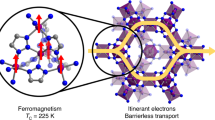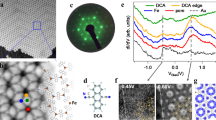Abstract
Organic ferromagnets, which exhibit exchange interactions between unpaired electrons in π-orbitals, are rare1,2,3,4,5,6, and the origin of ferromagnetism in these compounds has so far remained unexplained. Tetrakis(dimethylamino)ethylene–fullerene[60] (TDAE–C60) shows a transition to a ferromagnetic state with fully saturated s = 1/2 molecular spins at the relatively high Curie temperature (for organic materials) of 16 K (ref. 4). It has been suggested7,8,9 that the orientations of the C60 molecules may be important for ferromagnetism in this material, but in the absence of structural data at low temperatures there has been little progress towards understanding these microscopic interactions. Here we report the results of a comparative structural study of two different magnetic forms of TDAE–C60 crystals at low temperatures, correlating the structural properties—in particular, the intermolecular orientations—with the magnetic properties. We find that both ferromagnetism and spin-glass-like ordering are possible in this material, and depend on the orientational state of C60 molecules. This resolves the apparent contradictions posed by different macroscopic measurements4,10,11,12,13,14, and opens the way to a microscopic understanding of π-electron ferromagnetic exchange interactions in organic materials.
This is a preview of subscription content, access via your institution
Access options
Subscribe to this journal
Receive 51 print issues and online access
$199.00 per year
only $3.90 per issue
Buy this article
- Purchase on Springer Link
- Instant access to full article PDF
Prices may be subject to local taxes which are calculated during checkout



Similar content being viewed by others
References
Kahn, O. Molecular Magnetism (VCH, New York, 1993).
Nakazawa, Y. et al. Low-temperature magnetic properties of the ferromagnetic organic radical, p-nitrophenyl nitronyl nitroxide. Phys. Rev. B 46, 8906–8914 ( 1992).
Chiarelli, R., Novak, M. A., Rassat, A. & Tholence, J. L. A ferromagnetic transition at 1.48 K in a organic nitroxide. Nature 363, 147–149 (1993).
Allemand, P. M. et al. Organic molecular soft ferromagnetism in a fullerene C 60. Science 253, 301– 303 (1991).
Mrzel, A. et al. Ferromagnetism in cobaltocene-doped fullerene derivative below 19K due to unpaired spins only on fullerene molecules. Chem. Phys. Lett 298, 329–333 ( 1998).
Umek, P., Omerzu, A., Mihailovic, D. & Tokumoto, M. Synthesis and magnetic characterisation of fullerene derivative-based ferromagnets (3-nitro)- and (3-aminophenyl)-1-H-methanofullerene doped with cobaltocene. Chem. Phys. 253, 361–366 (2000).
Mihailovic, D. et al. Orientational and magnetic ordering of buckyballs in TDAE-C 60. Science 268, 400– 402 (1995).
Sato, T., Saito, T., Yamabe, T. & Tanaka, K. Spin-glassy phase of TDAE-C60 crystals. Phys. Rev. B 55, 11052–11055 (1997).
Tanaka, K. et al. Orientation dependent magnetic interaction in TDAE-C60 where TDAE is tetrakis(dimethylamino)ethylene. Chem. Phys. Lett. 259, 574–579 ( 1996).
Tanaka, K. et al. Ac magnetic susceptibility of TDAE-C60. Chem. Phys. Lett. 237, 123–126 (1995).
Tanaka, K. et al. Magnetic properties of TDAE-C60 and TDAE-C 70 where TDAE is tetrakis(dimethyl amino) ethylene. Phys. Rev. B 47, 7554–7559 ( 1993).
Venturini, P. et al. Magnetic resonance investigation of the magnetic transition in TDAE-C60. Int. J. Mod. Phys. B 6 , 3947–3951 (1992).
Blinc, R., Cevc, P., Arcon, D., Mihailovic, D. & Venturini, P. Time decay of the remanent magnetization in TDAE-C 60. Phys. Rev. B 50, 1– 3 (1994).
Arcon, D., Cevc, P., Omerzu, A. & Blinc, R. Ferromagnetic resonance in TDAE-C60. Phys. Rev. Lett. 80, 1529–1533 (1998).
Golic, L. et al. in Fullerenes and Fullerene Nanostructures (eds Kuzmany, H., Fink, J., Mehring, M. & Roth, S.) 531–534 (World Scientific, Singapore, 1996).
Arcon, D., Dolinsek, J. & Blinc, R. 13C NMR of the organic ferromagnet TDAE-C 60. Phys. Rev. B 53, 9137– 9142 (1996).
Omerzu, A., Mihailovic, D. & Tokumoto, M. Macroscopic magnetic measurements on the nonferromagnetic modification of TDAE-C60. Phys. Rev. B 61 , R11883–R11885 (2000).
Mrzel, A., Cevc, P., Omerzu, A. & Mihailovic, D. Interplay between antiferromagnetic and ferromagnetic phases of TDAE-C60: An ESR study of high-temperature annealed samples. Phys. Rev. B 53, R2922–R2925 (1996).
Dresselhaus, M. S., Dresselhaus, G. & Eklund, P. C. Science of Fullerenes and Carbon Nanotubes (Academic, San Diego, 1996).
Author information
Authors and Affiliations
Supplementary Information
Rights and permissions
About this article
Cite this article
Narymbetov, B., Omerzu, A., Kabanov, V. et al. Origin of ferromagnetic exchange interactions in a fullerene–organic compound. Nature 407, 883–885 (2000). https://doi.org/10.1038/35038032
Received:
Accepted:
Issue Date:
DOI: https://doi.org/10.1038/35038032
This article is cited by
-
Visible-light triggered photochemical reaction for the synthesis of dumbbell-like bis aminomethyl-1, 2 dihydrofullerene dimers via addition of α-amino radicals
Research on Chemical Intermediates (2021)
-
Magnetic effects in sulfur-decorated graphene
Scientific Reports (2016)
-
Magnetic Silicon Fullerenes: Experimental Exploration and Theoretical Insight
Journal of Cluster Science (2016)
-
Dynamically fluctuating electric dipole moments in fullerene-based magnets
Scientific Reports (2014)
-
Supramolecular self-assembly and nanoencapsulation of [60]fullerene by bis-β-cyclodextrin
Journal of Inclusion Phenomena and Macrocyclic Chemistry (2014)
Comments
By submitting a comment you agree to abide by our Terms and Community Guidelines. If you find something abusive or that does not comply with our terms or guidelines please flag it as inappropriate.



